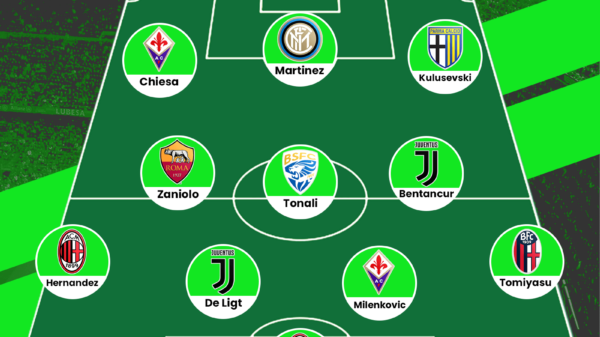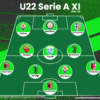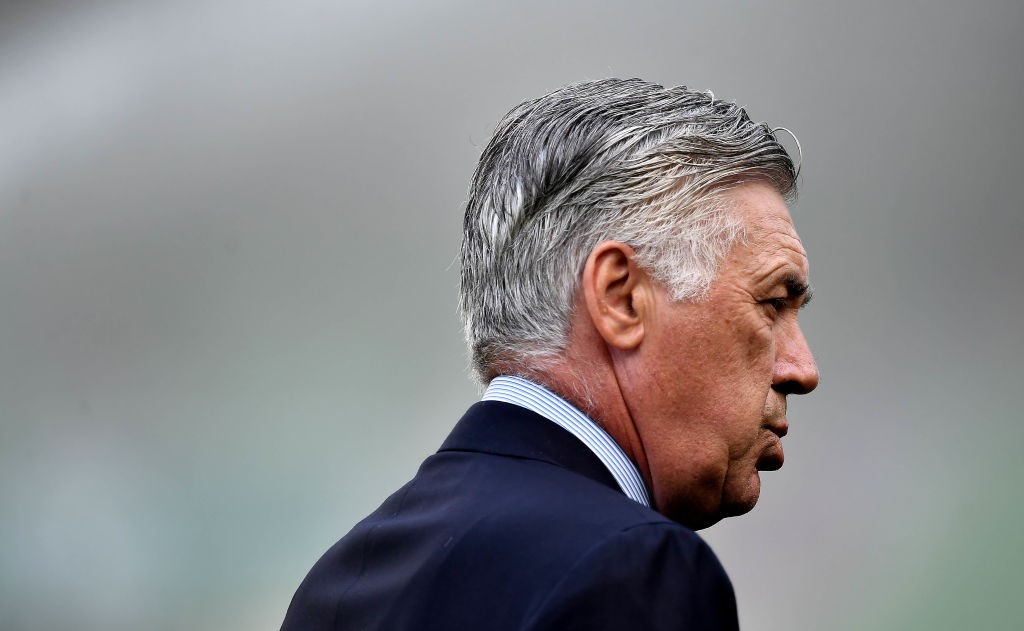Cheuk Hei Ho writes a detailed tactical analysis on the Serie A match that ended Juventus 2-1 Udinese.
In their debut under the new coach Gigi Del Neri, struggling Udinese visited Serie A leaders in the Juventus Stadium.

Made using TacticalPad
Juventus (4-4-2 / 3-5-2): Buffon; Lichtsteiner, Benatia (Bonucci 70), Barzagli, Evra; Cuadrado, Hernanes, Lemina, Alex Sandro; Dybala (Sturaro 81), Mandzukic (Higuain 66)
Udinese (3-4-2-1 / 4-1-4-1): Karnezis; Wague, Danilo, Felipe, Samir (Adnan 46); Fofana, Kums, Jankto (Heurtaux 75); De Paul (Perica 55), Duvan Zapata, Thereau
Juventus’ hybrid system
With a series of injuries and to rest players to prepare for the upcoming UCL encounter against Lyon, Juventus coach Massimiliano Allegri has fielded an experimental side with a hybrid system. Juventus used a standard 4-4-2 formation during the defensive phase with two full backs (Stephan Lichtsteiner / Patrice Evra) and two wide midfielders (Alex Sandro / Juan Cuadrado).

Juventus transitioned to a 3-5-2 formation during the offensive phase and initial build-up. Evra and Cuadrado would become the left and right wing backs. Alex Sandro took up the left central midfielder while Lichtsteiner took up the right center back position.

Allegri has insisted on playing the 3-5-2 for the last two years. The six players in the middle (three center backs and three central midfielders) facilitate procession in the center during the initial build-up. It also promotes ball circulation between the two sides through the center backs. In this game, with the absence of most of their center backs and central midfielders, Allegri was forced to play four players, who usually do not play in the center (Evra, Lichtsteiner, Alex Sandro and Cuadrado) together. The 4-4-2 during the defensive phase is a solution to this problem. It allows all four of these players to play in their natural positions. It also adds strength to a defensively weaker central midfield pairing featuring Hernanes.
A hybrid system is not uncommon because many teams play different formations during various phases of the game. What is unique in this hybrid system of Juventus is that it features two players to play in their unnatural position to facilitate the transition into the offensive shape (Lichtsteiner as the center back and Alex Sandro as the central midfielder). Allegri picked these players to play the most important roles during the formation transition is probably because of Lichtsteiner’s tactical intelligence and Alex Sandro’s versatile skill set (physical and can dribble the ball).
Juventus’ stable 4-4-2
Juventus played with the above 4-4-2/3-5-2 hybrid system for about 15 minutes in the first half. In this period, Juventus dominated procession (61%) but created little opportunities (1 shot to the goal). A major problem was their lack of creativity. Without Miralem Pjanic and Sami Khedira, Juventus lacked midfield’s penetration in the middle. Without Gonzalo Higuain, they also did not have a player who could hold the ball in the final third. These resulted in a lack of passes toward the box:
Juventus’s passes to the final third during the first 15 minutes of the first half:

via fourfourtwo.com
Without creating a lot of chances for about 15 minutes, Juventus players became impatient. Both Lichtsteiner and Alex Sandro would often play with their usual patterns rather than trigger the transition into the 3-5-2. In particularly, instead of staying at the back to facilitate procession, Lichtsteiner would surge down the right flank to support Cuadrado during the offensive phase. It resulted in Juventus playing a standard 4-4-2 in the offensive phase.

The changes of the formation from a 3-5-2 to 4-4-2 had significant influences on Juventus’s performance in the offensive phase. For example, they created 7 shots and 10 crosses from 15th to 45th minutes in the first half (compared to 1 shot and 4 crosses in the first 15 minutes). With Lichtsteiner supporting Cuadrado to create overloads and Paulo Dybala’s tendency to operate from the right side, Juventus would often create chances to penetrate in the middle.
Juventus’s passes to the final third from 15th to the end of the first half:

via fourfourtwo.com
While creating more chances with a 4-4-2, Juventus sacrificed the advantages of having six players in the center of the pitch, and therefore, they lost the control of the tempo of the game. For example, after they maintained a 4-4-2 formation (from 15th minutes to the end of the first half), Juventus only had 44% of the procession (compared to 61% in the first 15 minutes in the first half). Importantly, in a 3-5-2, the three center backs allow the team to circulate the ball between the two sides efficiently:

With a 4-4-2, when the full-back surges forward to join the winger, sometimes there is no player close to facilitate such ball circulation. For example, consider all the backward pass from Juventus in the first half.
Juventus’s backward passes in the first 15 minutes in the first half:

via fourfourtwo.com
Juventus’s backward passes from 15th to the end of the first half:

via fourfourtwo.com
In particular, the backward passes on the right flank were fewer and longer in a 4-4-2 (15th minutes to the end of the first half) compared to that of a 3-5-2 (first 15th minutes). It suggests that once committed to attack; it is a lot more difficult for Juventus to halt the offense and circulate the ball to the other sides. They would either create a shot or lost the possession. Therefore, Juventus created more potent offense, but they also could not limit the opponent from control the possession.
Juventus’ 3-4-2-1 in the second half
Allegri likes to control a game through the possession. However, the availability of the players did not allow him to play his preferred 3-5-2 with enough attacking power. To allow Juventus to maintain the potent offense but also control the possession of the same time, Allegri fielded a 3-4-2-1 / 3-4-3 formation in the second half.


In this formation, Barzagli was flanked by Benatia and Evra to form a three center backs backline. Lichtsteiner and Alex Sandro played the two wing back positions. Cuadrado played as an inverted winger on the left-hand side (same as Dybala on the right). With the inverted wingers and the wing backs, this formation maintains the advantage of the width in a 4-4-2. It also allows efficient ball circulation to the other sides through the three center backs.
Another notable point is that with Cuadrado and Dybala playing as the inverted wingers, it allows Juventus to attack the center quickly. In a standard 4-4-2 during the first half, the close Cuadrado was to the by-line, the more difficult he would be able to cut back towards the center (because he relies heavily on his right leg to control the ball). Therefore, it was easier for Udinese’s defenders to defend him even with Lichtsteiner overloading:

However, as the inverted winger, he can either cut towards the center or pass towards the by-line with the overloading of Alex Sandro if he does not stay close to the by-line:


Conclusion
With a stable 3-4-2-1 formation and the intense high pressing during the first 20th minute of the second half (8 attempted tackles, 4 in the opponent half compared to only six tackles, 1 in the opponent half), Juventus took control of the game and scored the go-ahead goal. After wasting several goal-scoring opportunities, Juventus sat back and absorbed the pressure.
Under the new coach, Udinese used a rather conservative approach to the game. They relied on the physical strength and pace of Duvan Zapata and Cyril Thereau to try to counter-attack if Juventus lost the procession while Lichtsteiner or Evra surged forward. Such simple tactics could not create too many problems for the Juventus’s defense. Once Juventus sat back, they could not create any genuine scoring opportunities. However, Udinese has many intriguing young prospects such as Rodrigo De Paul and Seko Fofana. It will be interesting to see how Del Neri transforms this team in the future.
In this game, Allegri was forced to experiment with different tactics and formations. However, he has also been experimenting other formations such as 4-3-3 (in the Empoli’s game). What he is trying to do is to create different hybrid systems based on their standard 3-5-2 formations. He has echo it in the post-match press conference: “I would like the team to be able to transform system during the match, depending on how the opposition is set out and at different times of the game. If they manage to do that, even without their Coach telling them to, it’ll mean they’ve reached a level of maturity to take on any team.” It will be interesting to see what their tactics will look like in the future
All of data presented here are from http://www.fourfourtwo.com/us/statszone and www.whoscored.com
Read all our tactical analyses here.

























































